As the world’s population grows, hunger persists on a massive scale
Nearly 1 billion people are malnourished, and a child dies of hunger every 11 seconds. By 2050, farmers would have to double crop production to meet the demand.
- Share via
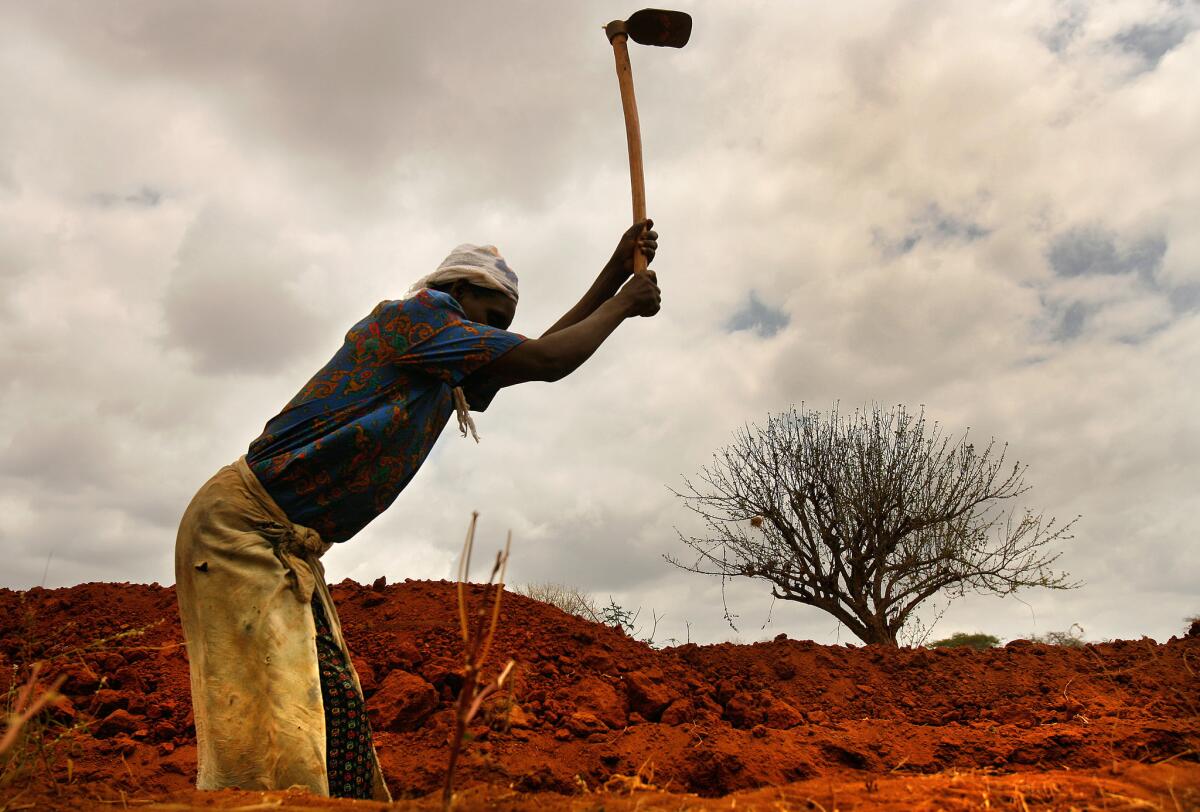
A farmer digs a trench in Kenya's Mwingi district, hoping to capture any rainwater that might come. As the world's population grows, researchers say, it will be increasingly difficult to produce enough food to feed everyone. (Rick Loomis / Los Angeles Times) More photos
July 22, 2012
Third of five parts
DADAAB, Kenya — His rib cage rose and fell with tight, rapid breaths.
Saad Siyat looked shrunken beneath the hospital blanket. His wide-set eyes rolled up into his head, and his body burned with fever.
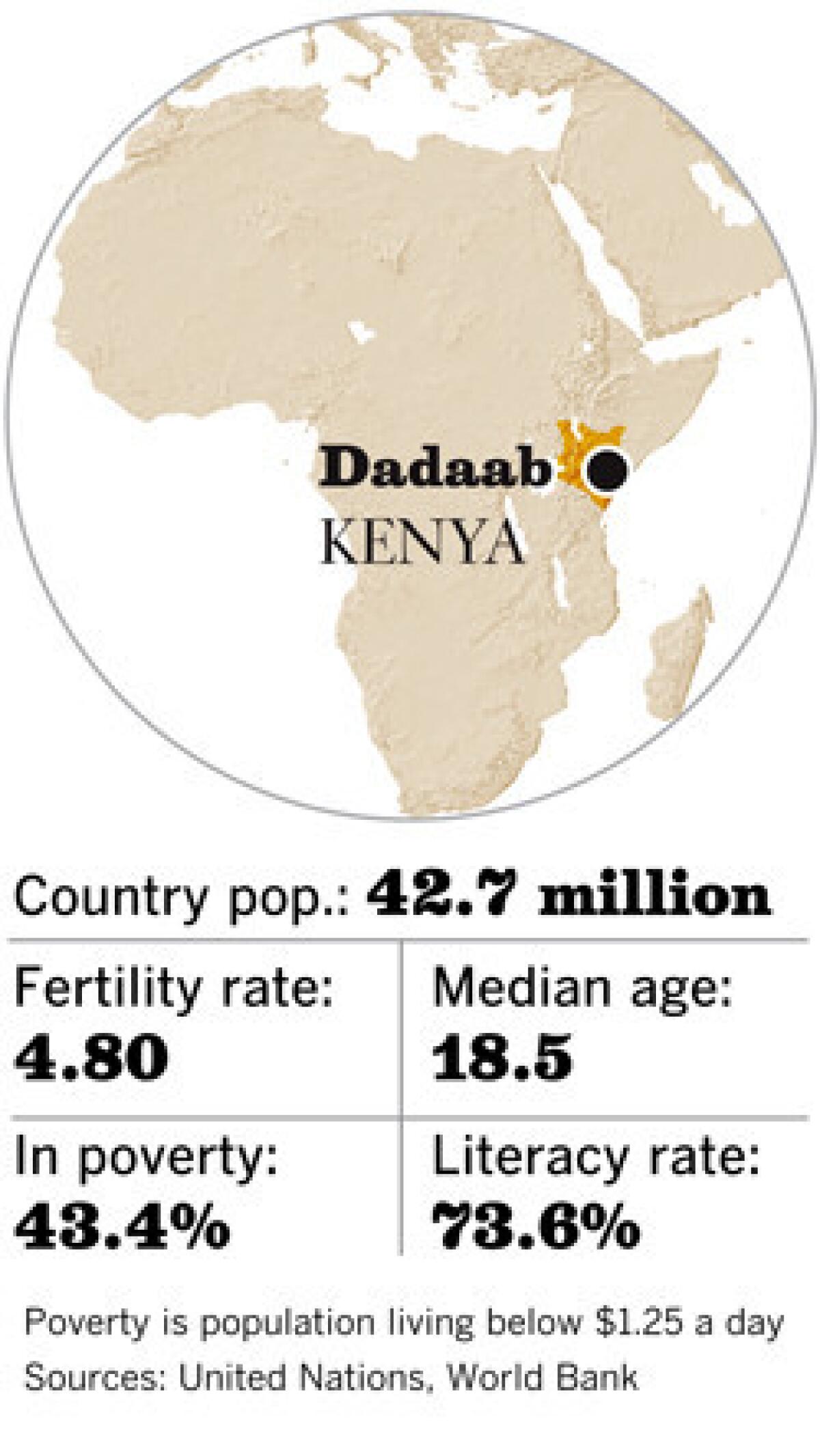
The boy was unconscious and convulsing when his aunt brought him to the hospital at Ifo camp, one of five massive camps in eastern Kenya filled with Somali refugees. The family had arrived months earlier after a nearly 300-mile journey across the desert.
Saad was suffering from pneumonia and chronic undernourishment — in particular, a protein deficiency known as kwashiorkor. The name derives from a West African term for "rejected one," a child pushed from his mother's breast to make way for a newborn.
Saad was 2½ years old. He weighed 18 pounds.
"This child has been sick a very long time," Dr. Ibtisam Salim said as she made her rounds in the hospital's stabilization center, a concrete building filled with emaciated children lying on squeaky metal beds.
She felt Saad's forehead and questioned his aunt, who was shooing away flies and using a soiled rag to wipe mucus from his oxygen and feeding tubes. The boy's mother was at home, tending to her seven other children.
Salim gently held up one of his feet, to show the swelling, a classic symptom of protein deficiency.
"Malnutrition opens up a very big window for infection," Salim said. "It destroys their defenses."
She heard a gasp and stiffened.
"Excuse me," she said, wheeling around on her heels and digging in her bag. She pulled out a stethoscope and held it to the boy's chest.
With the tips of three fingers, she began pumping rapidly on his frail torso.
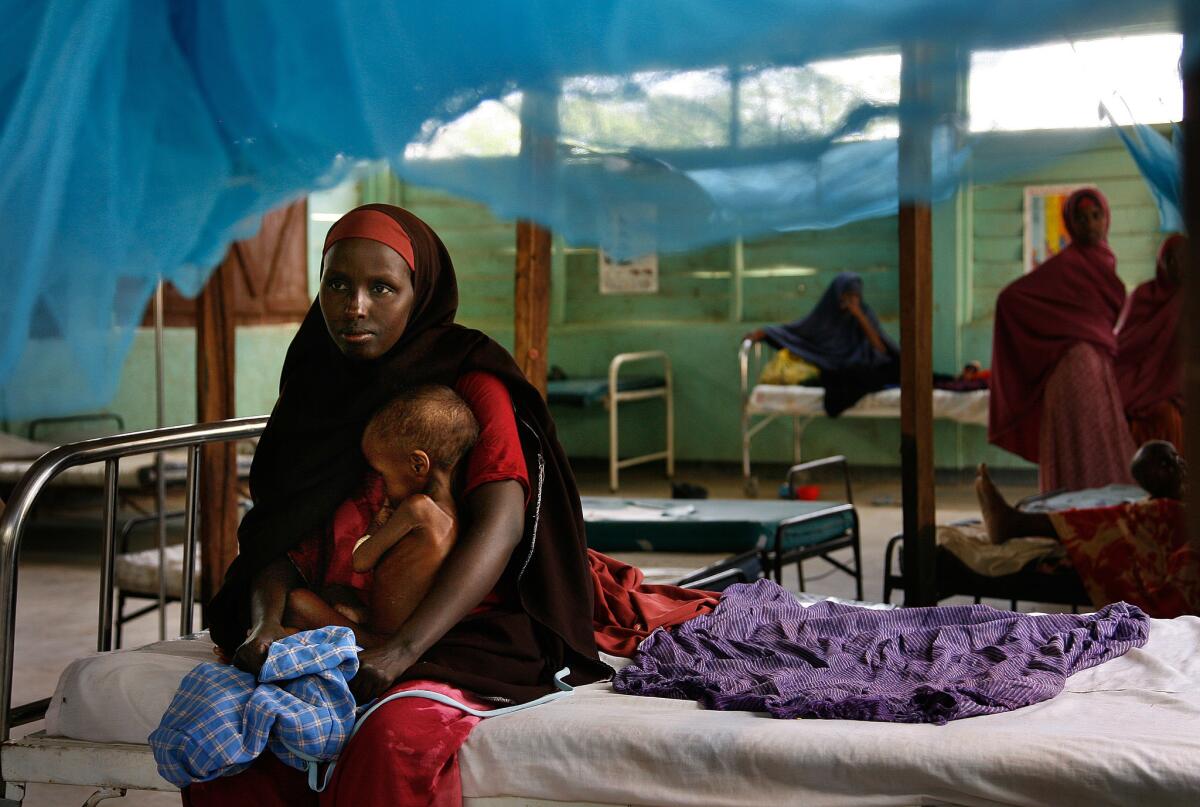
A woman holds a severely malnourished child at the Ifo camp in Dadaab. More people die of hunger-related causes every year than succumb to AIDS, malaria and tuberculosis combined. (Rick Loomis / Los Angeles Times) More photos
Around the world, population is rising most rapidly in places where life is most precarious.
Across Africa and in parts of South Asia and Latin America, hundreds of millions of people live on the edge of starvation. A drought, flood or outbreak of violence can push them over the brink.
Many end up on the march, crossing borders in search of relief. Some arrive in places like Dadaab, famished and desperately ill. Millions more are displaced within their own countries.
They represent one face of hunger in a world that, on paper at least, produces enough food to feed all 7 billion inhabitants.
Somalia, a nation of 10 million, has one of the highest birthrates in the world, averaging 6.4 children per woman. Runaway population growth, food scarcity and political strife have combined to cause a mass exodus. One-fourth of Somalis have fled their homes.
Last year, during the worst of a three-year drought, shortage turned to famine. Forty percent of Somali children who reached the refugee camps in Dadaab were malnourished. Despite emergency feeding and medical treatment, many died within 24 hours.
More commonly, children live on tenuously, the effects of chronic malnutrition masked by the swelling caused by kwashiorkor. By the time their parents realize how sick they are and take them to the camp hospital, it can be too late.
It has been four decades since advances in agriculture known as the Green Revolution seemed to promise relief from this kind of mass suffering.
An American plant breeder named Norman Borlaug won the Nobel Peace Prize in 1970 for helping to develop high-yield, disease-resistant varieties of wheat and other grains, making it possible to triple harvests around the world.
Mankind finally seemed to be gaining ground on its longtime nemesis: pervasive hunger.
Yet Borlaug cautioned against hubris: "The frightening power of human reproduction must also be curbed," he said. "Otherwise, the success of the Green Revolution will be ephemeral only."
Today, with nearly twice as many people on the planet, his words seem sadly prescient.
The farms have dried up. Some people had died of starvation.”— Shamsa Adow Hassan,
a Somali refugee
Nearly 1 billion people are malnourished, according to the U.N. Food and Agriculture Organization. At least 8 million die every year of hunger-related diarrhea, pneumonia and other illnesses — more than succumb to AIDS, malaria and tuberculosis combined. A child dies of hunger every 11 seconds.
In raw volume, the world's farmers produce enough food for everyone. People go hungry in developing countries because they can't afford to buy food and can't grow enough on their own. Inadequate transportation and storage aggravate shortages.
By midcentury, global food production could simply be insufficient. There will be at least 2 billion more mouths to feed, and an expanding middle class will consume more grain-fed beef, pork and other meats.
To meet the demand, the world's farmers will have to double their crop production by 2050, according to researchers' calculations.
Jonathan Foley, a University of Minnesota climatologist, says it's the challenge of the 21st century: "How will we feed 9 billion people without destroying the planet?"
Most of Earth's best farmland is already under cultivation, and prime acreage is being lost every year to expanding cities and deserts, contamination from agricultural chemicals and other causes.
Carving large new tracts of farmland out of the world's remaining forests and grasslands would exact a heavy toll, destroying wildlife and unleashing climate-warming gases now locked in soils and vegetation.
Complicating the problem is that rivers and aquifers are running dry, and heat waves and droughts associated with global warming are withering crops. Pests and diseases thought to have been vanquished are bedeviling farmers again, often in more virulent forms.
Major international research projects are underway to develop hybrid crops to withstand these challenges. But such efforts take decades, and there is no guarantee of success.
"The easy things have been done," said Nina V. Fedoroff, a biotechnology expert at Pennsylvania State University. "The problems that are left are hard."
The traditional low-tech solution to hunger — mass migration —is increasingly impractical on a crowded planet.
The looming crisis is expected to be most severe in Africa, where birthrates are high and where the Green Revolution never took hold. By midcentury, the continent's population is expected to double — to 2 billion.
Africa already is home to nearly 30% of the planet's chronically hungry. About 400 million people in sub-Saharan Africa live on less than $1.25 a day, most of which is spent on food.
Increasingly, they are competing with the appetites of wealthier nations, which are snapping up some of Africa's best rain-fed farmland to secure long-term food supplies. The U.S., China and other countries are also using more grain to fatten livestock and make ethanol, pushing up prices.
All of this leaves more and more people on the edge.
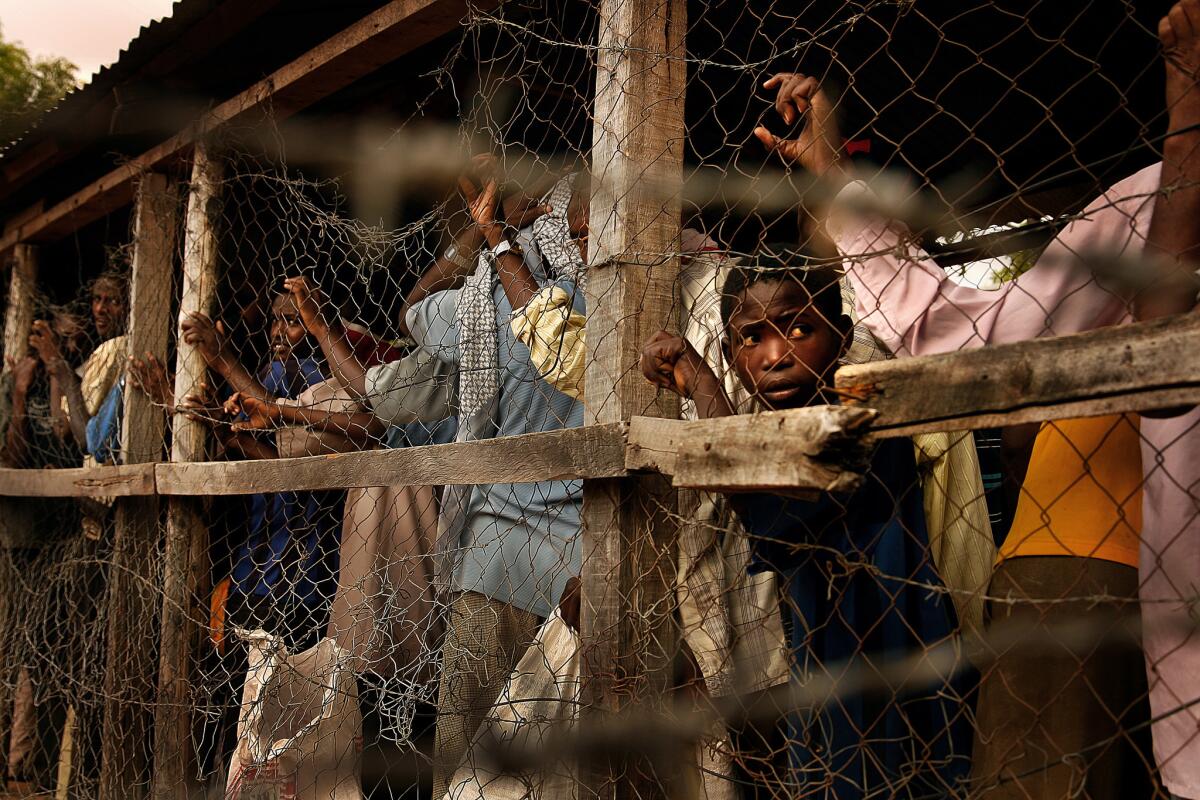
At a camp in Dadaab, people lined up to receive food are funneled through tunnels similar to cattle chutes. Through openings at various intervals, aid workers scoop wheat flour, cornmeal, dried peas, soy protein powder and salt into the refugees' gunnysacks. (Rick Loomis / Los Angeles Times) More photos
When it opened in 1991, the camp complex in Dadaab was intended as a temporary shelter for 90,000 Somalis. It now holds the world's largest concentration of refugees: 472,000 and counting.
On a blistering morning, more than 1,000 new arrivals massed outside the fence. Most had trudged through the desert for days or weeks.
Guards bellowed at the mob with bullhorns and swatted men with switches to herd them into lines. Lone refugees were rare; the lines contained families of eight, 10 or more.
Nearly all the newcomers were skinny, some skeletal. As they shuffled through processing stations, workers measured their outstretched arms for body fat. Children were immunized against measles and polio and given a squirt of vitamin A.
Clutching her ration card in one hand and cradling a 2-month-old girl with the other, Shamsa Adow Hassan said she had fled her riverbank farm in Somalia with her husband and four children.
"The farms have dried up," said Hassan, 32. "Some people had died of starvation."
She decided to leave when a rocket struck and killed her father.
At the center of one camp, the new arrivals joined other refugees lining up with empty sacks, plastic jugs and tins to receive two-week rations of food staples. To keep women from being trampled, security officers in white coats put the men in separate lines.
After some jostling and a sprint to the entrance, the refugees made their way through large tunnels similar to cattle chutes, fashioned from barbed wire, chain-link fencing and corrugated metal. Through openings at various intervals, aid workers scooped wheat flour, cornmeal, dried peas, soy protein powder and salt into the refugees' gunnysacks.
Thousands of tons of food are distributed in these camps every year by the U.N.'s World Food Program and other aid organizations. The U.S. government pays most of the cost. Worldwide, the U.N. program feeds an average of 90 million people per year.
On this day, not far from the chutes, Mohamed Abdi Yussuf was holding forth, encircled by some of the camps' younger leaders. They were talking about crowding, the lack of water and a shortage of flour.
Even so, Yussuf said he wanted to have as many children as possible.
At 26, with three children, he is just getting started.
How many does he want? "Seventy," he said. "Sixty boys and 10 girls."
This brought some tittering from his fellow youth leaders. He didn't crack a smile.
"I think these guys will support me," Yussuf said. "Our elders, our fathers, had many children. It's a common idea."
He hadn't consulted his 21-year-old wife and said he planned to divorce her before she turns 40.
"When she stops breeding, I will jump to another young lady."
Asked how he would provide for all those children, Yussuf shrugged.
"I don't worry what the children will feed on," he said. "They have their own fate. They have their own mouths, teeth. God knows what to put in there."
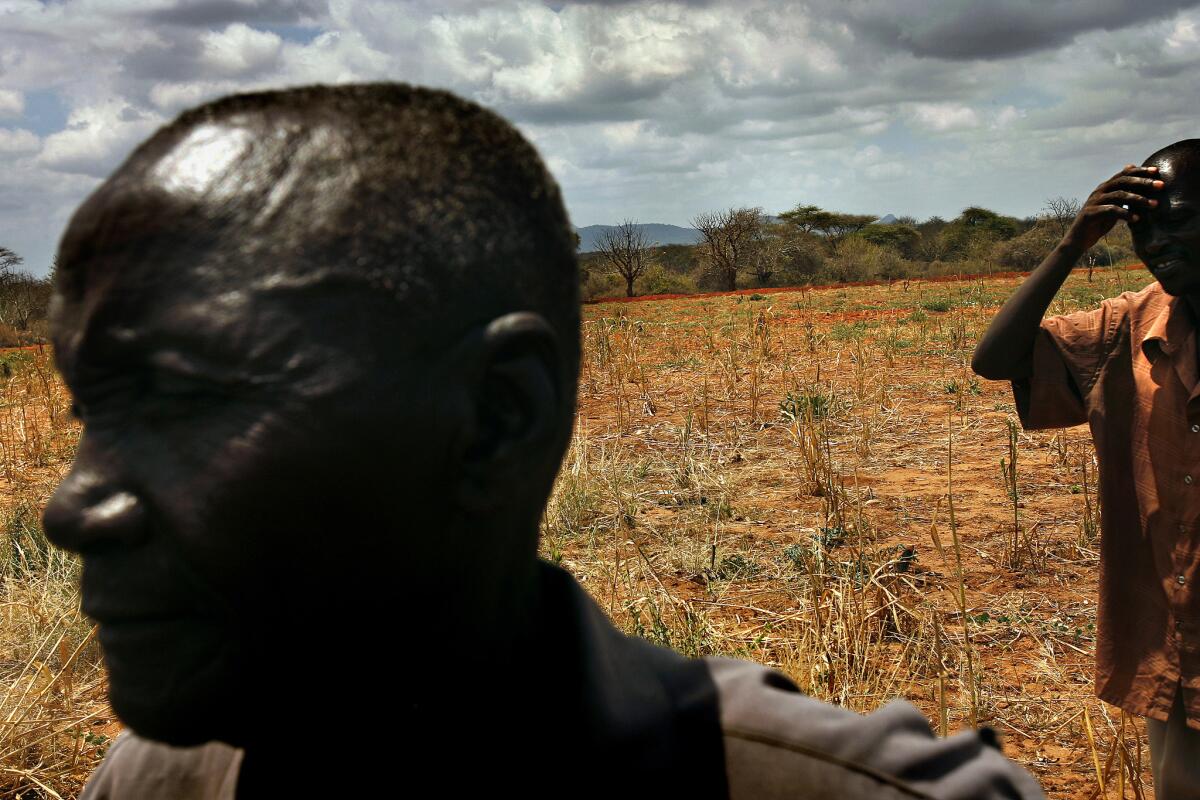
James Mukunga, left, has dealt with years of drought-ruined crops on the small farm he shares with his wife and 12 children in eastern Kenya, about 200 miles from the refugee camps. The family chopped down their few remaining trees to make charcoal to sell. (Rick Loomis / Los Angeles Times) More photos
James Mukunga worries every day about how to feed his children.
Outside Dadaab, across the arid expanses of East Africa, farmers like him are struggling to provide for large families. Once-fertile grasslands have been overgrazed and trampled by herds of goats and cows.
Mukunga lives with his wife and 12 children, 27 goats and one donkey on a small farm 200 miles from the refugee camps.
The skinny Kenyan farmer wore tattered clothes and kicked at a shriveled patch of millet with sandals fashioned from car tires. Stunted stalks of corn, sorghum and other plants poked through sun-baked clay.
This year, like the one before, his crop had failed because of drought. "Since 2004, we have not had a reasonable harvest," Mukunga said.
The family chopped down their few remaining trees to make charcoal to sell. Otherwise, they subsist on donated food from the United States. Their small granary is empty but for a few spent cans of vegetable oil labeled "USAID."
Mukunga wonders if his goats, a source of meat and milk, will survive another dry year.
The family gets its water from a village borehole four miles away. It was a mob scene on this hot day. Dozens of women toting jerrycans waited in the shade of an acacia tree, next to herds of scrawny goats and cattle. A cow licked an empty spigot.
The water pump had run out of diesel fuel, and a few men had gone off to find some.
Hours passed as the thirsty waited for relief.
At the hospital at Ifo camp in Dadaab, Dr. Salim used her fingers to spread Saad's upper and lower eyelids and shined a light into a pupil. Then she went back to work, compressing his chest.
Somali women covered head to toe in brightly colored scarves and dresses crowded around the bed.
A nurse squeezed through with a syringe of adrenaline.
"He's gasping," Salim said, tilting Saad's head back to open his airways.
The boy's aunt, with large frightened eyes, climbed onto the bed, squatting on her haunches. She poured water into his mouth from a red plastic cup.
"Mama, please, please, please ... Mama, please," Salim said, gently moving the woman's arm out of the way.
The doctor continued the chest compressions, faster now.
An assistant brought a hand-pumped respirator. Salim placed a clear plastic mask over the boy's nose and mouth and began squeezing the bag.
As she pumped air into his lungs, she handed her stethoscope to a nurse and said: "Listen — listen to the heart."
She watched as the nurse leaned over the child.
"Is there any heartbeat?"
The nurse met her gaze with a weary expression that left no doubt.
"There isn't," Salim said.
The doctor stepped away from the bed, leaned against the wall and silently wept.
About the series
Los Angeles Times staff writer Kenneth R. Weiss and staff photographer Rick Loomis traveled across Africa and Asia to document the causes and consequences of rapid population growth. They visited Kenya, Uganda, China, the Philippines, India, Afghanistan and other countries.
Sign up for Essential California
The most important California stories and recommendations in your inbox every morning.
You may occasionally receive promotional content from the Los Angeles Times.










